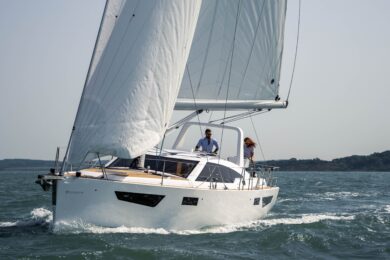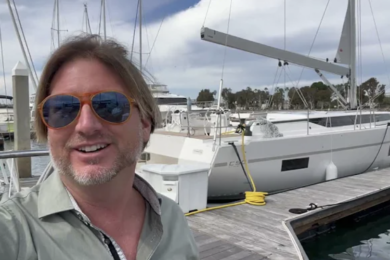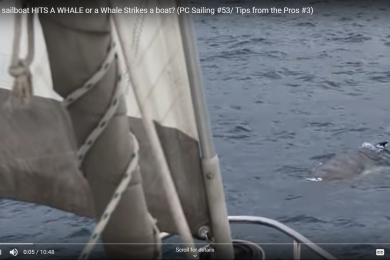There is a plethora of choices when it comes to sails for offshore passagemaking but as always there is the struggle between how many sails to carry on board and where to store them. Fortunately one sail never needs to be stored and that’s your mainsail (published November 2015)
The mainsail is, as the name implies, the most important sail in the inventory and for good reason. When you are sailing upwind, it’s the back of the main that works in conjunction with the keel to provide lift, when you are reaching it’s what you use to balance the helm, and downwind it’s all about projected area and mainsails project pretty well.
With that in mind let’s look at the various choices you have for mainsails. There are many with each having their own benefits and drawbacks. Before we look at the different kinds of sails let’s think a little about sail geometry. In his terrific book The Art and Science of Sails, Tom Whidden compared the optimal mainsail shape to the wing of a RAF Spitfire jet. Without getting too technical, the elliptical shape of the wing is a much more efficient surface for generating lift. The worst shape, according to Whidden, is a triangle which is precisely the shape of an in-mast furling mainsail, yet these mains are becoming increasingly popular mostly due to the ease with which you can set and reef your sail.
A standard in-mast mainsail has a hollow leech. The sailmaker cuts it this way to prevent it fluttering and the hollow further exacerbates the triangular shape of the sail. Without any roach it’s a very inefficient shape for windward work and downwind it’s not much better because of the loss of sail area. On a reach, however, it’s fine. You can use it to balance the helm just as you would a regular mainsail. For many sailors heading offshore reaching is the most desired point of sail and if your offshore passage calls for lots of wind on the beam then you won’t be as hurt by the loss of sail area when compared to other mainsail types.
There are some things that you can do to mitigate the inefficient sail geometry. It is possible to add vertical battens to the sail. These battens run parallel to the mast meaning that they can be rolled away into the mast cavity. By adding vertical battens you are able to get the leech back to a straight line, possibly with a little roach but definitely not the kind of roach you would see on a conventional main. There are some sailmakers that advocate full length vertical battens in order to add a decent roach to the sail, but after talking to numerous riggers I would advise against it. There are too many complications that come with trying to roll everything into a mast cavity designed to accommodate just a sail and not a sail with a bunch of bulky battens.
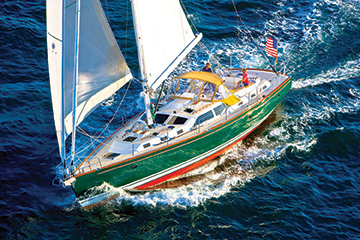
IN-BOOM FURLERS
With the sail area and overall geometry compromised with an in-mast furling main, there has been a push toward in-boom furling sails and they are catching on in popularity for many reasons, mainly simplicity. Sailors don’t like the hassle of reefing and unreefing and they don’t like being limited by how much or how little sail area they can remove with each reef. With an in-boom furling system there are, for all practical purposes, limitless reef positions, however it’s best to reef to each batten. In-boom furling mainsails are all fully battened usually with more battens than you would find in a conventional fully battened main. You should reef the sail until the batten is just on the mandrel. That way the batten acts to keep the foot of the sail stretched tight and the bag out of the sail. This is especially important since the last thing you want in a building breeze is a full mainsail. The batten pocket itself lends reinforcement to the sail at each “reef point.”
One of the drawbacks of in-boom furling systems is that they require a high level of skill from both the sailmaker as well as the sailor. These are not simple sails to make because the goal is to get the sail to roll up smoothly on the mandrel. Oversize patches or patches in the wrong place can result in an uneven roll which will effect how the sail goes in and out of the boom cavity. In addition the overall profile of the sail is important. While in-boom systems go a long way toward providing a powerful main with sufficient roach to power the boat to windward, it’s unwise to attempt to add too much sail area. Ultimately, an even curve from head to clew will provide an even rollup in the boom cavity.
It’s also important that the boat be set up correctly for an in-boom furling unit. Make sure that you have all the right deck hardware to handle the system and that you have it mounted where you can operate all the control lines efficiently. For example, be sure that the furling line is close to the mainsail halyard so you can release one and take up on the other, all the while maintaining the correct tension on the halyard. Too little tension and the roll will travel forward; too much tension and the roll will travel aft. The boom vang is also an important piece of equipment when using an in-boom furling system, not so much for controlling leech tension, but for controlling boom height. This is because keeping the boom at the appropriate level is important for the sail to roll up evenly. If the outboard end of the boom is too high, the luff of the sail will start to travel aft. Conversely, if the outboard end of the boom is too low, the luff will travel forward.
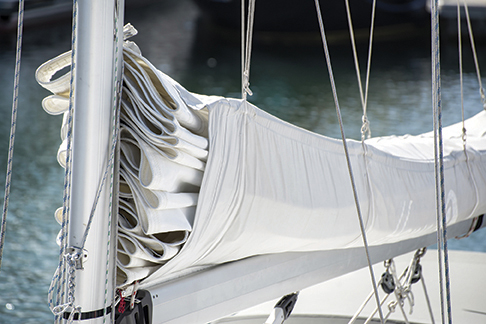
LAZY JACK SYSTEMS
Because of the complication and drawbacks of trying to furl your mainsail in the mast or boom, it’s no wonder that most cruisers still opt for a conventional mainsail. They are the most reliable even if they do require more work when it comes to reefing and unreefing the sail. Fortunately there are some things that you can do to make it easier to manage the sail. Full length battens, when used with some kind of lazy jack system, make it a lot easier to manage the sail. My preference is for two full length battens up high and standard length battens through the reef area. The full length battens up high lend stability and smooth out the sail shape. Leaving them out down low gives you much more control over the depth of camber in the sail. If you have full length battens down low their stiffness usually dictates the overall sail shape. With regular length battens down low you can adjust the foot tension to add or remove depth to the sail. Fewer battens also means a lighter sail and that’s important when it comes to trimming in lighter winds.
Lazy jacks are by far the most popular way of managing a conventional mainsail. They are inexpensive and simple to use. Some sailors prefer the Dutchman system which is permanently mounted on the sail. Working like a Roman shade, a kit system can be used to retrofit an existing mainsail or installed on a new sail. The secret is a series of grommet holes running the length and width of the sail. Fed through these holes are control lines that attach to fittings at the base of the sail. The control lines are also attached to the topping lift and run perpendicular to the boom. When the mainsail is being lowered or reefed the control lines tame the mainsail so that it simply slides down the lines and flakes neatly on the boom.
The Dutchman works best on new sails because once the sail has been raised and lowered a few times, the fabric develops a “memory” and the sail starts to fold naturally along the same lines. By the same token, the system does not work that well on old, soft sails since it’s hard for old sails to develop any kind of memory. The drawback is that because the sail folds along the same line the hinge effect will wear out the fabric over time.
Many sailmakers combine a set of lazy jacks with the boom cover. Doyle call it their StackPack, Mack Sails call it the MackPack. At Island Planet Sails we call it the IP LazyPack. Essentially, they are the same thing. A set of lazy jacks are attached to the boom cover which usually has some kind of rigid batten supporting the upper edge. When the sail is lowered it falls easily into the boom cover which is then zippered closed. When the sail is raised each side of the boom cover lays flat out of the way against the mainsail.
REEFS
Most sailors going offshore will opt to have a minimum of two sets of reefs. In fact going out of sight of land with just a single reef is unseamanlike. There is a debate about whether of not you need a third reef and there are some good arguments on either side. If you need to get rid of sail area you can do so with two deep reefs. You can save the extra weight and additional cost of a third reef. On the other hand with three rows of reefs you can keep the sailplan more balanced by reducing sail in smaller increments. Don’t forget that the designer of the boat calculated sail sizes and probably reef sizes in order to keep the center of effort in the right place as you change gears through the wind range. Consult the owners manual in case there are some notes from the designer in regards to reefs.
On the inboard end of each reef it’s better to have a short strop led through the reef eye with rings on either side which can be hooked over the reef hook at the gooseneck. This is much neater and simpler than trying to leverage the reef ring over the reef hook. If you think you will have the reef in for a while by all means lash it to the boom by running reef lines through the eyelets that run across the sail, but don’t forget the safety line at the outboard end. You need to back up the outboard reef line with a separate line led through the reef eye and lashed around the boom. Without the safety line, should the reef line break or someone inadvertently eases it off and you have the sail lashed, you run the risk of ripping the body out of the sail from luff to leech.
ADDITIONAL TIPS
Leechlines are an absolute necessity on all mainsails. As wind exits off the back end of the main it creates tiny vortices which cause the leech to flutter. You need to tighten up on the leech line to remove the flutter. On smaller boats, where you can easily reach the outboard end of the boom, it’s okay to have a simple leech line that is adjustable at a point just above the clew. On larger boats where it would be impractical trying to adjust a leech line at the clew end, the lines are led over the top of the sail, down the luff inside a little pocket to the tack of the sail where it can be adjusted. Some sailors like double overhead leech lines so that they can adjust them from the windward side and not have to hang under the boom like a contortionist flapping in the breeze.
If you are heading to the tropics, there are some things you can do to extend the life of your sail. Many tropics bound sailors will ask that their sailmaker use PTFE thread. PTFE is an acronym for Polytetrafluoroethylene which is essentially teflon and the yarns that result are very UV resistant and also because they are quite slippery, they are also chafe resistant. Many sailmakers sew UV sunshields and patches with PTFE thread, but it’s not a bad idea to have your whole sail sewn with the thread. The alternative is to ask your sailmaker to use a heavier yarn for sewing your sails. Because heavier yarns have more mass they are able to withstand more UV and chafe before losing their strength.
To decide what the right mainsail is for you and your sailing plans take a long hard look at your priorities. If performance is near the top of your list then maybe a conventional main with a decent size roach and a set of lazy jacks is for you. If convenience is king then an in-mast furling main may just be the ticket. As with all your sails much of the success of how each sail will perform is up to how skilled you are at getting the most out of it and this most definitely applies to your mainsail.
Brian Hancock is a sailmaker, author, lecturer and veteran offshore sailor and racer. He lives in Marblehead, Mass.
PERSONAL ANECDOTE
In 1999, I sailed a well-appointed 44-foot cruising yacht from Newport, Rhode Island, to the Azores. The yacht was equipped with electric winches, a spacious galley, a push-button flushing head and an in-mast furling system. It was, to say the least, heavily reliant on electrical power. Three days into the passage, however, the whole charging system collapsed, and my crew and I (we were sailing double-handed) had to rely on alternative means to manage the boat. In addition to not having electric winches, which was certainly not a problem, we lost all the food in the freezer and could not use the stove because the gas shut-off sensor relied on electricity for it to function. Worst of all, the automatic in-mast furling system did not work because it was electrically driven and all reefing and unreefing had to be done with a small hand-crank that was attached to the mandrel. 300 turns of the crank would reduce the sail area by about 20 percent. We perfected the process by making sure that there was absolutely no friction on the sail where it entered the mast cavity. We also made sure that we reduced sail well in advance of approaching wind. It was an excellent lesson in remembering that sometimes simplicity is the best solution.

